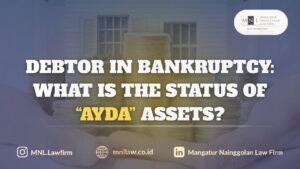
What is AYDA?
Agunan Yang Diambil Alih (“AYDA”) or Foreclosed Collateral refers to assets acquired by a bank, in whole or in part, either through a public auction or outside of an auction process, based on voluntary surrender by the collateral owner or pursuant to a power of attorney to sell outside an auction, in circumstances where the debtor has failed to fulfill their obligations to the bank.
For banks, AYDA represents an alternative resolution for non-performing loans (NPLs) to suppress NPL ratios. The NPL ratio directly affects the Capital Adequacy Ratio (CAR). A higher NPL ratio may result in a lower CAR. Should the CAR fall below 8%, the bank faces the risk of liquidation for being deemed unable to absorb potential losses.
AYDA Is Not a Sale and Purchase of Collateral Assets
In consideration of the impact of NPLs on CAR, Article 12A of Law of the Republic of Indonesia No. 10 of 1998 concerning the Amendment to Law No. 7 of 1992 regarding Banking (“Banking Law”) permits commercial banks to acquire, in whole or in part, collateral through a public auction or outside of an auction process, either based on voluntary surrender by the collateral owner or pursuant to a power of attorney to sell outside an auction, in cases where the debtor fails to perform their obligations to the bank, with the proviso that the acquired collateral must be liquidated immediately.
The phrase “the acquired collateral must be liquidated” imposes a duty on the bank not to indefinitely retain such collateral but to promptly dispose of it in order to recover the funds disbursed.
Status of AYDA in Bankruptcy Proceedings
When a debtor or obligor of the bank is declared bankrupt, all of the bankrupt debtor’s assets are subject to a general attachment (sita umum) to be administered and settled by a bankruptcy receiver (Kurator) under the supervision of a supervisory judge (vide Article 1 of Law No. 37 of 2004 concerning Bankruptcy and Suspension of Debt Payment Obligations [“Bankruptcy Law”]).
The debtor’s bankruptcy has legal consequences on the status of AYDA, particularly regarding whether AYDA forms part of the bankruptcy estate (boedel pailit). Inclusion or exclusion of AYDA in the bankruptcy estate depends on the ownership status (“bezit”) of AYDA at the time the debtor is declared bankrupt.
- If ownership of AYDA has not yet been transferred when the debtor is declared bankrupt, AYDA will be deemed part of the bankrupt debtor’s assets and, mutatis mutandis, included in the bankruptcy estate. This is consistent with Article 21 of Law No. 37 of 2004, which provides that bankruptcy includes all assets of the debtor at the time the bankruptcy judgment is rendered, as well as all assets acquired during the bankruptcy process.
- Conversely, if ownership of AYDA has already been transferred to another party prior to the debtor’s bankruptcy declaration, AYDA does not form part of the bankruptcy estate. Nevertheless, the validity of such transfer must first be ascertained.
The status of AYDA in bankruptcy cases is further clarified by Circular Letter No. 3 of 2023 on the Implementation of the Formulation of the Supreme Court Plenary Chamber Meeting 2023 as Guidelines for the Judiciary (“SEMA No. 3 of 2023”), which stipulates that as long as AYDA remains unsold, the bank retains its status as a separatist creditor, and the AYDA asset is part of the bankruptcy estate.
Conclusion
The status of AYDA upon a debtor’s declaration of bankruptcy hinges on the ownership status of AYDA.
- If AYDA ownership has been transferred from the bank to a third-party purchaser prior to the debtor’s bankruptcy declaration, it is excluded from the bankruptcy estate.
- If AYDA remains under the bank’s control without a completed transfer of ownership at the time of bankruptcy, AYDA will form part of the bankruptcy estate.
Legal Basis
- Law of the Republic of Indonesia No. 37 of 2004 concerning Bankruptcy and Suspension of Debt Payment Obligations.
- Law of the Republic of Indonesia No. 10 of 1998 concerning Amendments to Law No. 7 of 1992 regarding Banking.
- Financial Services Authority Regulation No. 40/POJK.03/2019 concerning Assessment of Asset Quality for Commercial Banks.
- Supreme Court Circular Letter No. 3 of 2023 on the Implementation of the Formulation of the Supreme Court Plenary Chamber Meeting 2023 as Guidelines for the Judiciary.
Author: Salma Ariana Taruna, S.H.
Co-author: Eva Rutnauli Sinaga
Editor: Muhammad Arief Ramadhan, S.H.
